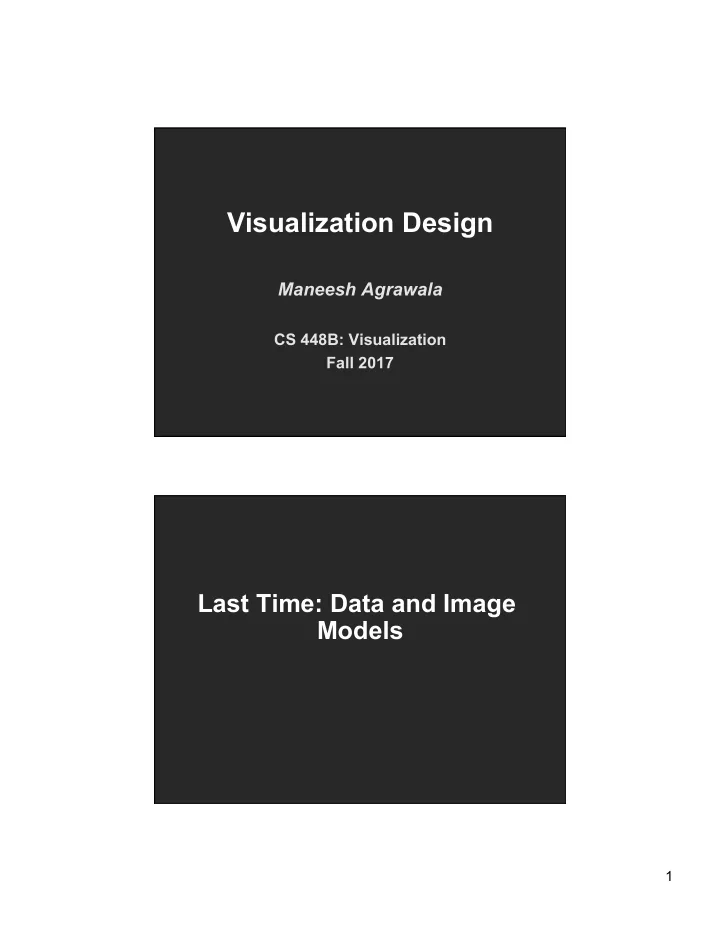

Visualization Design Maneesh Agrawala CS 448B: Visualization Fall 2017 Last Time: Data and Image Models 1
The big picture task data processing physical type algorithms image int, float, etc. visual channel abstract type retinal variables nominal, ordinal, etc. mapping visual encoding domain visual metaphor metadata semantics conceptual model [based on slide from Munzner] Nominal, ordinal and quantitative N - Nominal (labels) Fruits: Apples, oranges, … Operations: =, ≠ O - Ordered Quality of meat: Grade A, AA, AAA Operations: =, ≠ , <, >, ≤ , ≥ Q - Interval (location of zero arbitrary) Dates: Jan, 19, 2006; Loc.: (LAT 33.98, LON -118.45) Like a geometric point. Cannot compare directly Only differences (i.e. intervals) may be compared Operations: =, ≠ , <, >, ≤ , ≥ , -- Q - Ratio (location of zero fixed) Physical measurement: Length, Mass, Temp, … Counts and amounts Like a geometric vector, origin is meaningful Operations: =, ≠ , <, >, ≤ , ≥ , -, ÷ On the theory of scales of measurements S. S. Stevens, 1946 2
Marks and Visual Variables Marks: geometric primitives points lines areas Visual Variables: control mark appearance Position (2x) Size Value Texture Color Orientation Shape Semiology of Graphics J. Bertin, 1967 Playfair 1786/1801 Time à x-position (Q, linear) ■ Exports/Imports Values à y-position (Q, linear) ■ Exports/Imports à color (N, O, nominal) ■ Balance for/against à area (maybe length??) (Q, linear) ■ Balance for/against à color (N, O, nominal) ■ 3
Bertins ’ “ Levels of Organization ” N Nominal N O Q Position O Ordered Q Quantitative N O Q Size N O Value Note: Q < O < N Q N Texture O N Color Note: Bertin actually N Orientation breaks visual variables down into differentiating N Shape ( ≠ ) and associating ( ≡ ) Mackinlay ’ s expressiveness criteria Expressiveness A set of facts is expressible in a visual language if the sentences (i.e. the visualizations) in the language express all the facts in the set of data, and only the facts in the data. 4
Cannot express the facts A one-to-many (1 → N) relation cannot be expressed in a single horizontal dot plot because multiple tuples are mapped to the same position Expresses facts not in the data A length is interpreted as a quantitative value; ∴ Length of bar says something untrue about N data [Mackinlay, APT, 1986] 5
Mackinlay ’ s effectiveness criteria Effectiveness A visualization is more effective than another visualization if the information conveyed by one visualization is more readily perceived than the information in the other visualization. Subject of perception lecture Mackinlay ’ s ranking Conjectured effectiveness of the encoding 6
Graphical Perception Most accurate Position (common) scale Position (non-aligned) scale Length Slope Angle Area Volume Least accurate Color hue-saturation-density APT: Automatic Chart Construction Encode most important data using highest ranking visual variable for the data type Year ear Exports Exports Imports Imports 1. Year (Q) 1700 170,000 300,000 2. Exports (Q) 1701 171,000 302,000 3. Imports (Q) 1702 176,000 303,000 ... ... ... mark: lines Year à x-pos (Q) Exports à y-pos (Q) Imports à y-pos (Q) Automating the design of graphical presentation of relational information J. Mackinlay, 1986 7
[Mackinlay, APT, 1986] Limitations Does not cover many visualization techniques ■ Bertin and others discuss networks, maps, diagrams ■ They do not consider 3D, animation, illustration, photography, … Does not model interaction 8
Announcements Announcements Class participation requirements ■ Complete readings before class ■ In-class discussion ■ Post at least 1 discussion substantive comment/question by noon the day after lecture (short paragraph) Office hours on website Class wiki https://magrawala.github.io/cs448b-fa17 9
Assignment 2: Exploratory Data Analysis Use Tableau to formulate & answer questions First steps ■ Step 1: Pick a domain ■ Step 2: Pose questions ■ Step 3: Find data ■ Iterate Create visualizations ■ Interact with data ■ Question will evolve ■ Tableau Make wiki notebook ■ Keep record of all steps you took to answer the questions Due before class on Oct 16, 2017 Assignment 1: Visualization Design Barley Yields Due by noon on Mon Oct 2 Submissions of PDF via Canvas, bring printout to class 10
Design Considerations Expressiveness ■ Do the mappings show the facts and only the facts? ■ Are visual mappings consistent? (e.g., respect color mappings) Effectiveness ■ Are perceptually effective encodings used? ■ Are the most important data mapped to the most effective visual variables? Cognitive Load (Efficiency) ■ Are there extraneous visual elements? Data Transformation ■ Are transformations (filter, sort, derive, aggregate) appropriate? Guides (Non-Data Elements) ■ Descriptive, consistent: Title, Label, Caption, Source, Annotations ■ Meaningful references: Gridlines, Legend Design Space of A1 Submissions Spatial Encoding Bar charts, Maps, Scatterplot, Pie Color Encoding Mostly ordered or nominal (year, loc.), Quantitative (dual encoding) Data Transformation Aggregation (avg. yield across variety) Labeling Title, Caption, Axis labels, Legends Not many annotations 11
12
13
In-Class Review Procedure Break into groups of 3 Present your visualization – in order by last name – 3 min each to describe what your visualization shows, and design choices. Others should write down critique on sheet We will keep time and tell you to switch Critique in order by last name – rubric on next slide (~5 min each) Tell author your critique. ■ Give critiques to author ■ Author take photos of critiques and add to A1 along with a short response (1 paragraph) to the feedback. In-Class Review Expressiveness ■ Do the mappings show the facts and only the facts? ■ Are visual mappings consistent? (e.g., respect color mappings) Effectiveness ■ Are perceptually effective encodings used? ■ Are the most important data mapped to the most effective visual variables? Cognitive Load (Efficiency) ■ Are there extraneous visual elements? Data Transformation ■ Are transformations (filter, sort, derive, aggregate) appropriate? Guides (Non-Data Elements) ■ Descriptive, consistent: Title, Label, Caption, Source, Annotations ■ Meaningful references: Gridlines, Legend 14
Recommend
More recommend